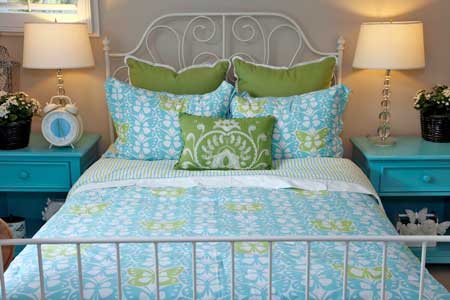
When you’re building up your home staging portfolio, it’s tempting to include every home staging photo you’ve taken in your client’s home.
This can be a real pitfall because you should only show the most effective photos.
In general, even 3 sets of before and after shots are enough to capture a potential client’s attention and generate interest in working with you.
Not only do you want to avoid showing too many photos of the same room, you also want to avoid overloading potential clients with too many photos at once.
Here are 5 tips to choosing the most effective before and after photos for your home staging portfolio.
1. Pretend you’ve never been in the room when looking at your photos.
While you might know your home staging services resulted in a dramatic transformation, if that’s not evident from the photos alone, they don’t belong in your portfolio.
We need have a more objective eye when evaluating our photos because the viewer doesn’t know (or care about) the rest of the story.
Look at what’s going on in the photos, not what you remember from the room itself.
2. Don’t rely on long photo captions to sell your transformation.
To be effective, a dramatic home staging transformation must be obvious at first glance.
Potential clients shouldn’t need to study the photos to see what tiny things are different, or read a long and detailed caption.
You’ve heard a “picture says a thousand words.” Your photos have to be strong even without a caption.
3. Show a range of home staging situations.
Unless you intend to specialize exclusively in vacant or resale homes don’t show all of one type or the other.
If all your before photos are empty rooms then a home seller looking for a home stager to work on their resale home might think, “She only does vacant homes. She’s not appropriate for us because we already have a house full of furniture.”
Conversely, if all your before and after photos demonstrate how you’ve rearranging the furnishings that were already there, the seller of a vacant property will assume you don’t stage vacant homes.
Your range should also include different rooms and different styles if possible. Perhaps one of your home staging portfolio pairs is a traditional dining room while another is a modern living room for example.
Similarly, ensure your portfolio is relatable to the average client you’re targeting. If most people in your target area live in modest homes, show one of those in your portfolio.
4. Demonstrate more than your cluttering busting talents.
The biggest, and most common, home staging portfolio pitfall to avoid is showing a bunch of before and after photos that just show de-cluttering.
Most often new home stagers make this mistake with kitchens. The only thing that’s different is they’ve taken all the junk off the counters and the photos off the front of the fridge. Otherwise, it’s exactly the same kitchen.
That’s a wasted opportunity to sell your home staging services because potential clients looking at these photos will think, “I’ve got to de-clutter my kitchen. I can do that myself.”
An effective home staging portfolio makes a potential client think, “Wow! I never would have thought of doing that on my own. I need this home stager to get results like this in my own home.”
5. Get opinions if you can’t decide which pairs to choose.
If you can’t decide which of your home staging photos to choose, it might be helpful to put 6 or 10 sets of before and after photos in front of other people and ask:
“Which do you think are the most dramatic transformations and why?”
Try and avoid doing this in a group. You’ll get a better range or honest reactions one-on-one.
Their opinions may or may not be valid, especially if they aren’t representative of your target market. That’s why it’s good to ask “why?”
They might tell you a reason and you realize that its not really representative of most people.
 While outside opinions can be helpful (and provide insights you hadn’t thought of), take their opinions with a grain of salt.
While outside opinions can be helpful (and provide insights you hadn’t thought of), take their opinions with a grain of salt.
Ultimately you have to make the final selections for your own home staging portfolio.
Please add to the comments section. Let me know if these tips were helpful, share your own, or ask me anything you like about home staging photos so I can address these in a follow up article.



So true, Debra. Staging is about visual perceptions. Just like you wrote a while ago now, when you are meeting a client, stage yourself in the way you dress. So, when presenting your work online, stage your portfolio so what professional difference you make and your scope is obvious through your chosen photos. Just makes sense!
Hi Patricia, thanks so much for commenting!
I’d love to write an article about your home staging business. I know it’s been years since you took the Staging Diva Program. You can submit a story idea/details at this link: https://stagingdiva.com/homestagingbusiness/staging-success-stories/
Then I take it from there, write a story and give you free online publicity 🙂
Thanks again for taking the time to comment!
Choosing portfolio pictures is tough. It’s like trying to stage your own home. You have to try to step away from the photos for a while and view them with fresh eyes.
I like to wait a little before choosing which transformations are the most dramatic. It always bums me out just a little when the pictures do not show the true transformation. Sadly, you can’t really attach the feeling you get when you walk into the space to these images. So often, a home that was dramatically transformed may only have a few good pictures of the transformation. The key, as you said, is to pick the best. Luckily a picture paints a thousand words, so having less is OK!
I’ve also asked friends and family to help pick the best transformations. It’s definitely helpful and most of the time reinforces your gut feeling. Ultimately though, we know our business best and we’ll have to decide.
Sometimes I dread this process and wonder if all the time I spend on it is worth it, but when I get positive feedback from those that have seen my site, newsletter and/or blog, it makes it all worth it!
Susan, thanks so much for sharing this. I know you will help many home stagers with your experience.
I also like to look at my photos when I can have a bit more distance from the project to be more objective. It always feels like I’m going through hundreds of shots to whittle it down to a few good ones.
From my time on professional photo shoots when I was in marketing years ago, I’d watch “real” photographers do the same thing and take hours to compose the perfect shot. Of course those photos were having to live in an expensive print ad in a magazine, but still good to know that it takes time for everyone to get it right.
Thanks again for commenting.
What would you recommend for a new home stager when they have no vacant houses to show in their portfolio?
Laura, if you really want to have some, take furniture out of one of your rooms and then put it back! The point being that you want to show how much better a home looks with furniture in it than without.
Great article and reminders! Thank you!
Happy to help Sharon!
I am proud my before and after. So does everyone else. However they are dramatic and targeted to my audience. I struggle with quality of the photos. I am exploring photo editing beyond my phone’s capabilities.
Hi Patty, there are plenty of online photo editing apps that you can use to improve your photos.
I explain ways to take better photos and how to edit them in the Staging Diva Ultimate Portfolio Guide.
Thanks for commenting. You might also find this article helpful. It will give you tips for How To Fix Your Home Staging Photos.